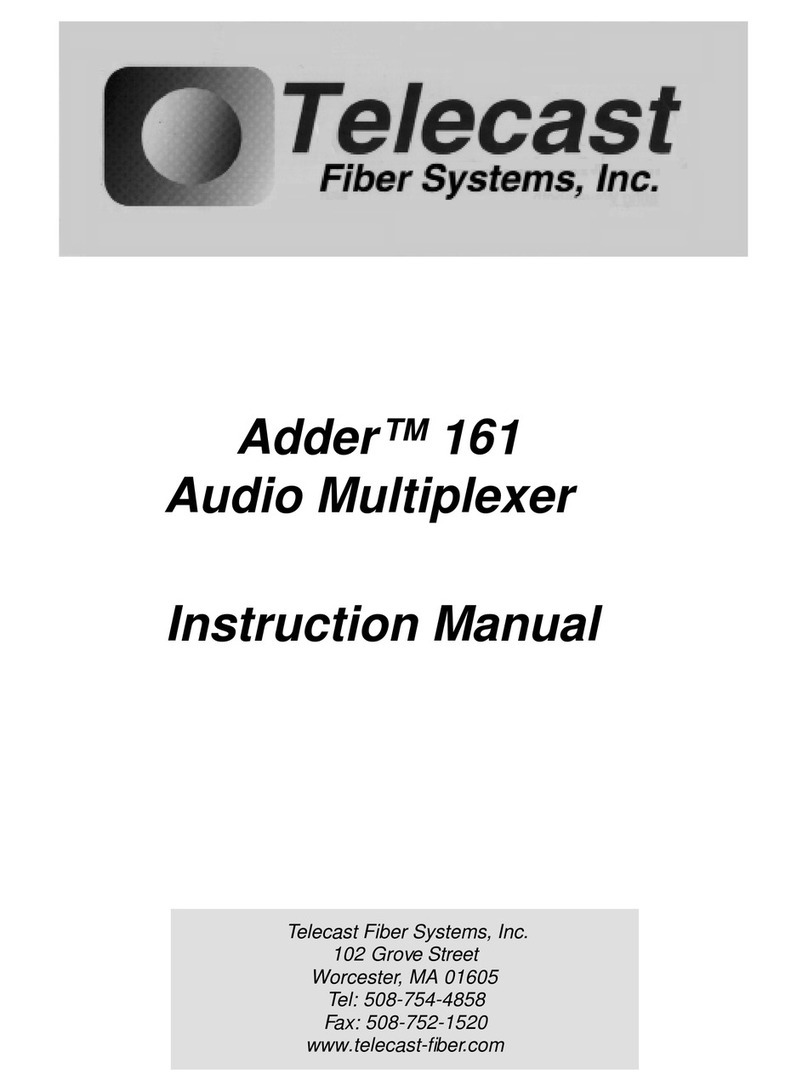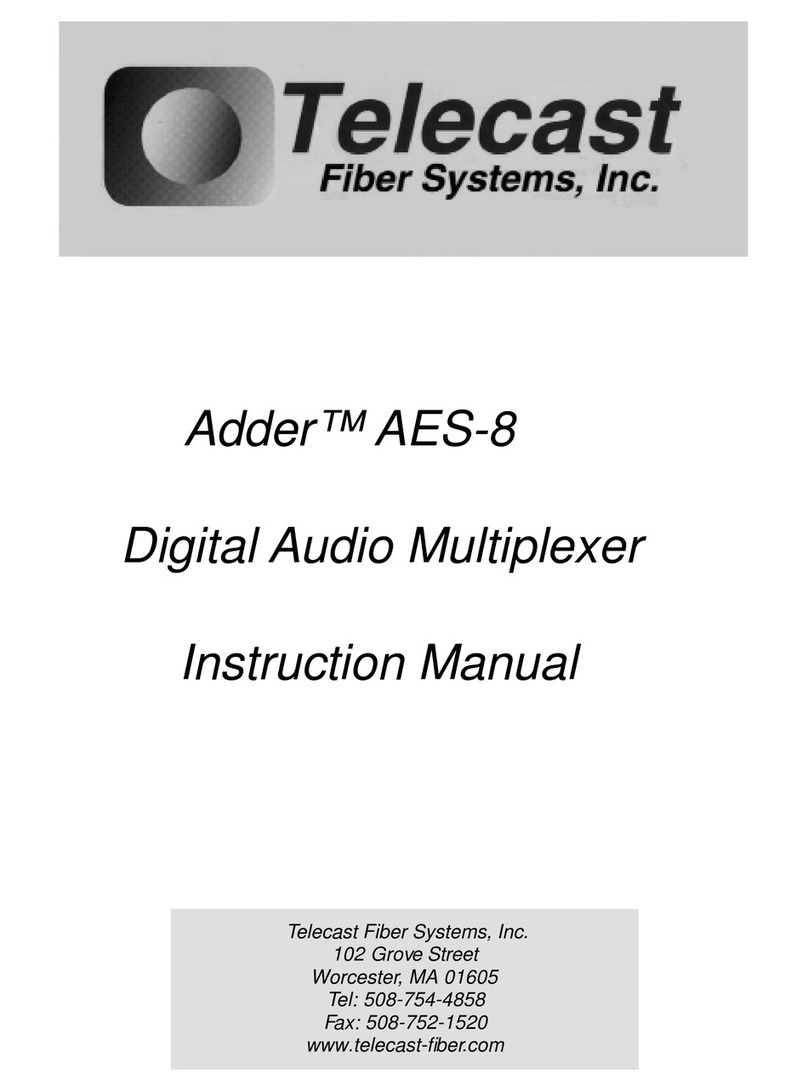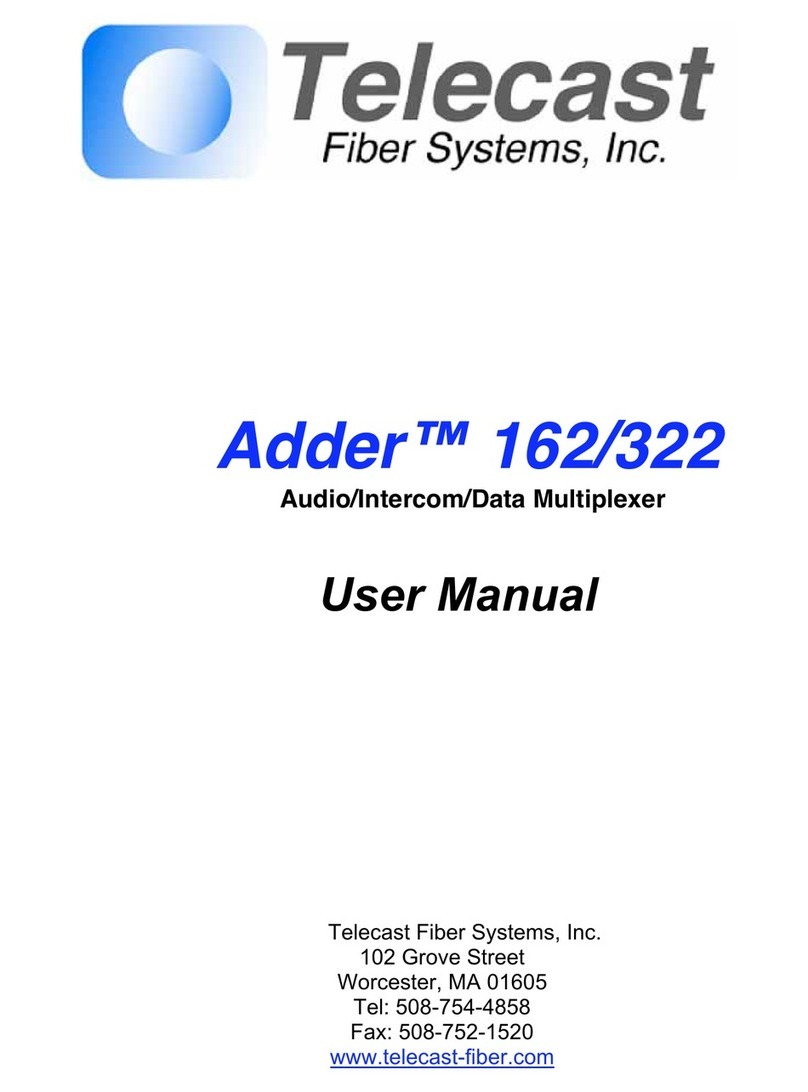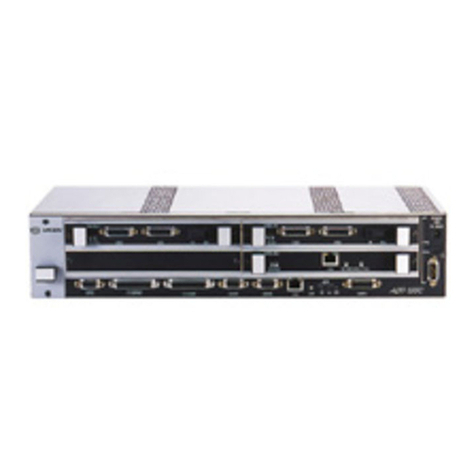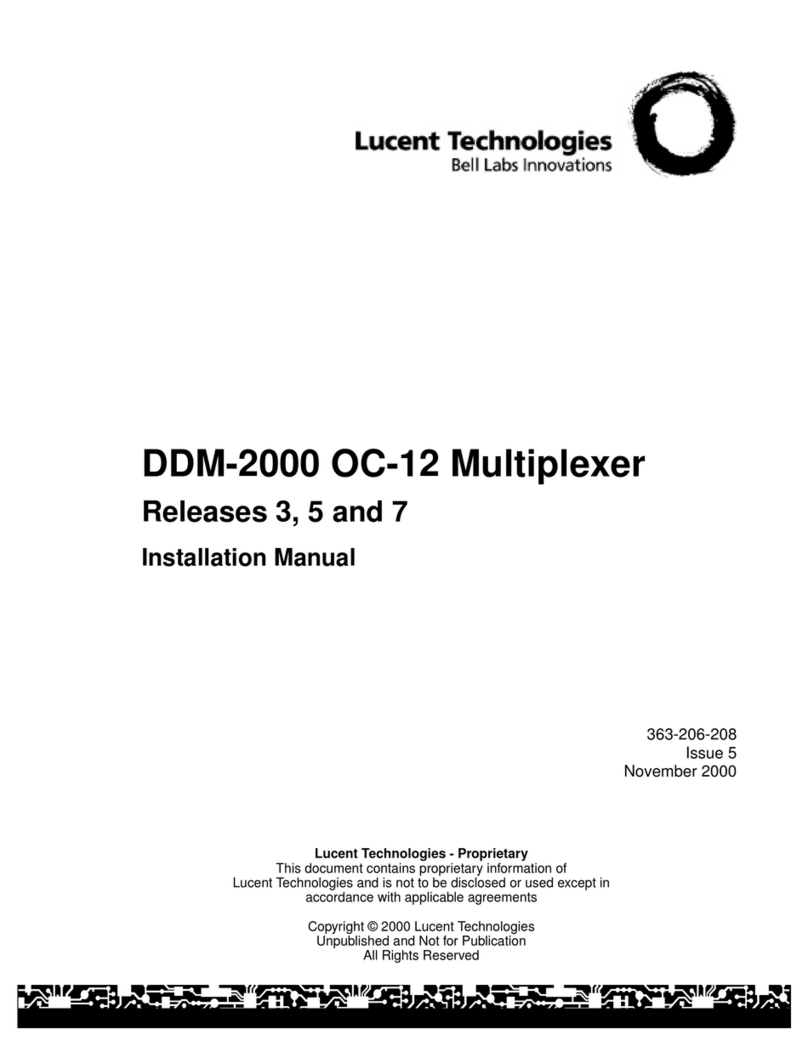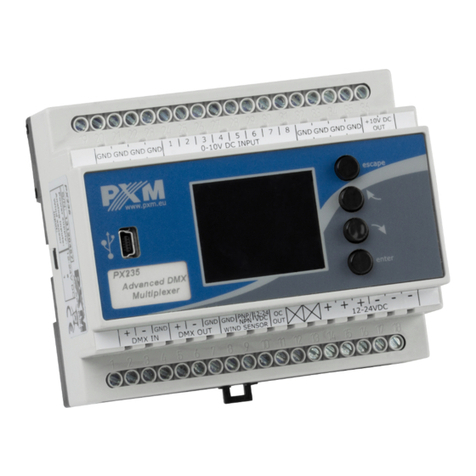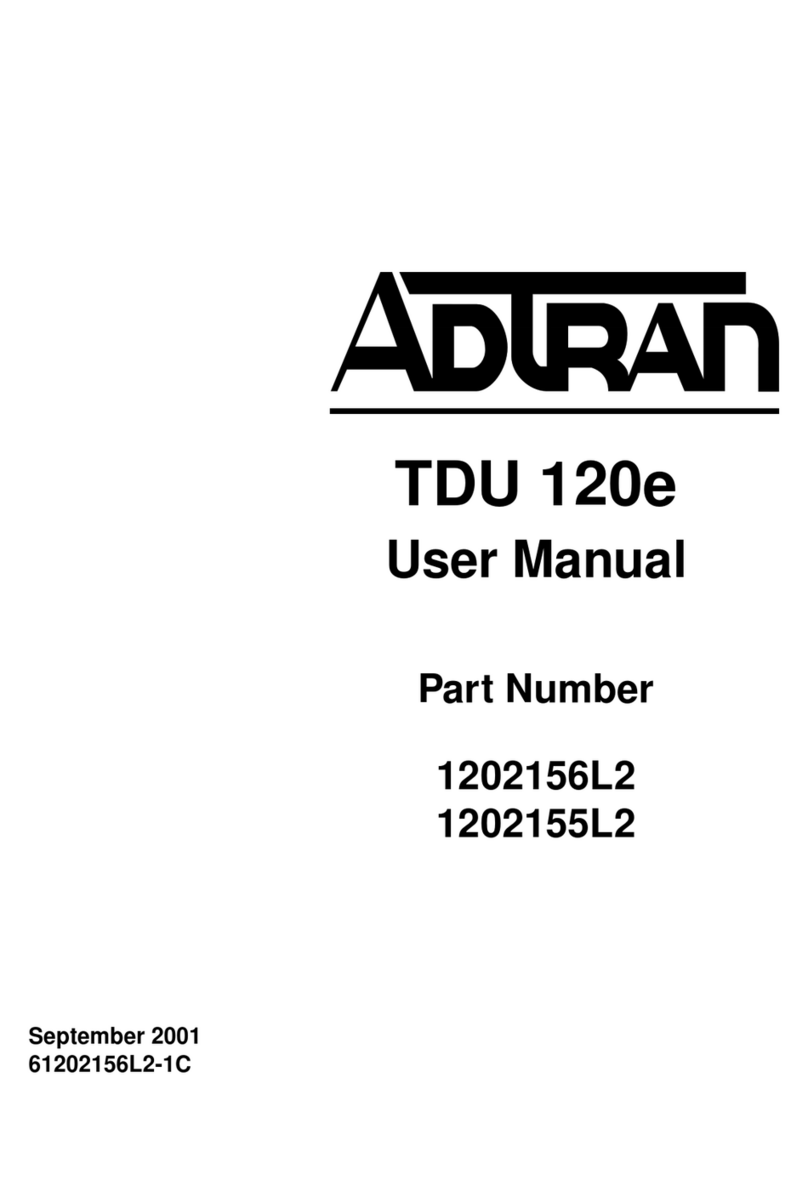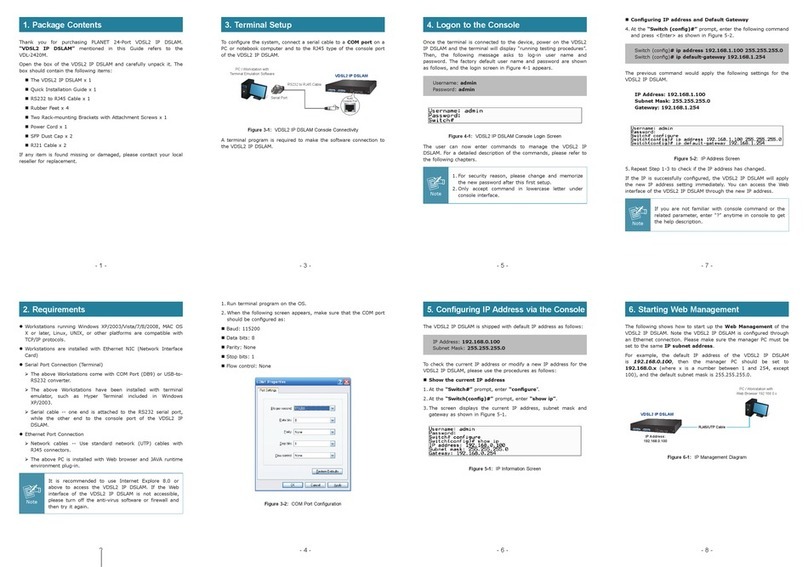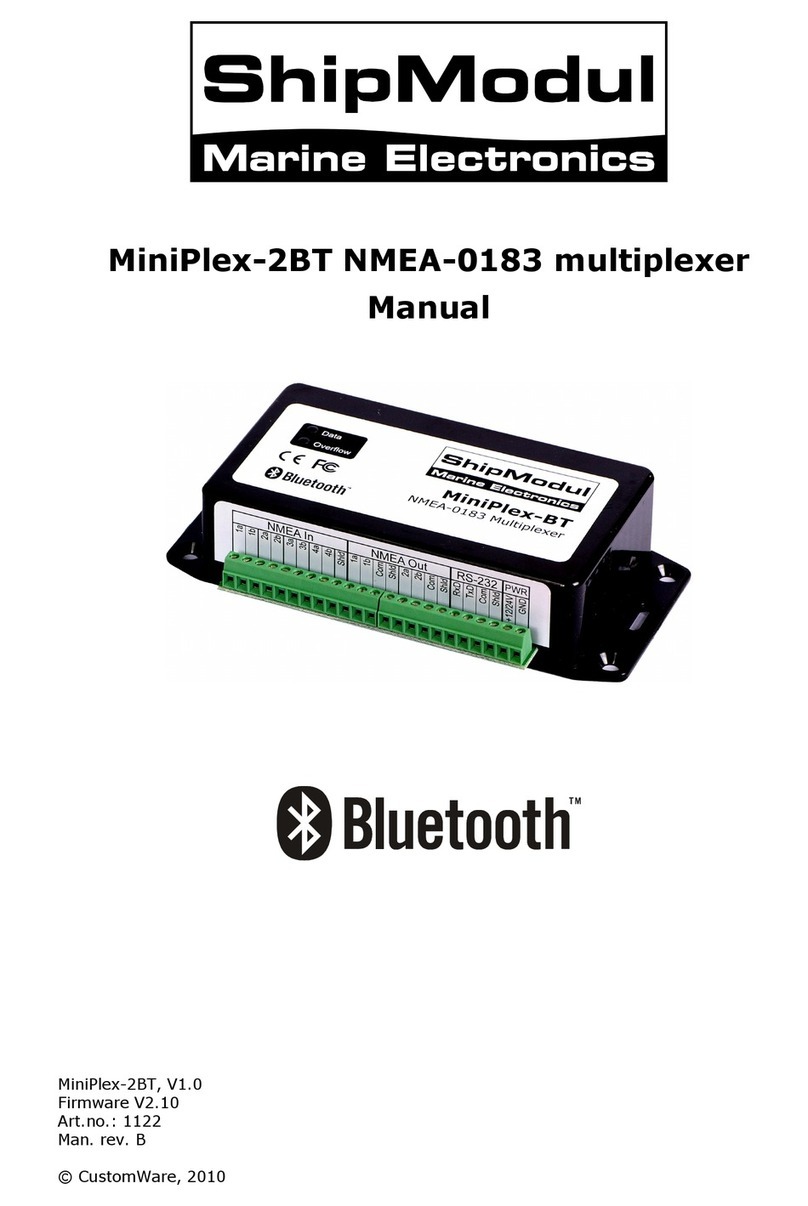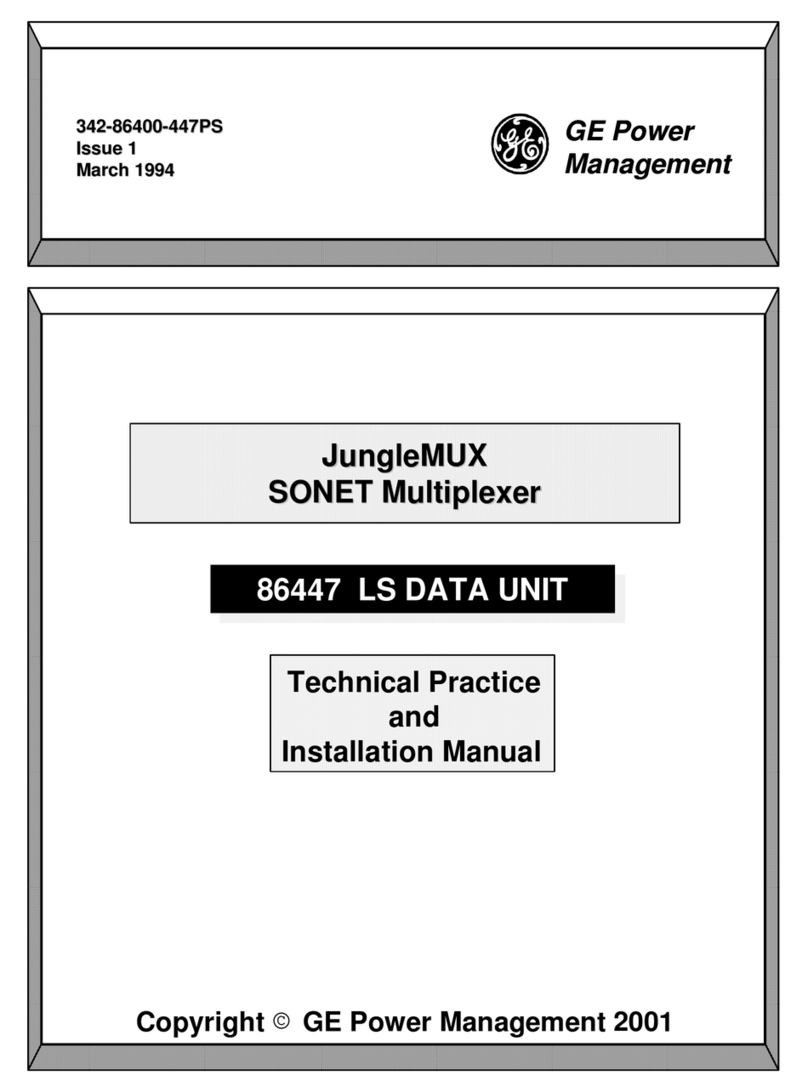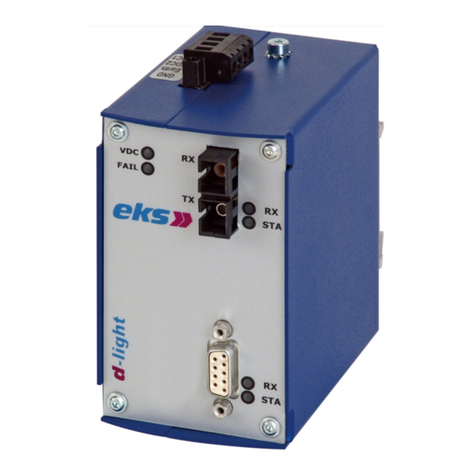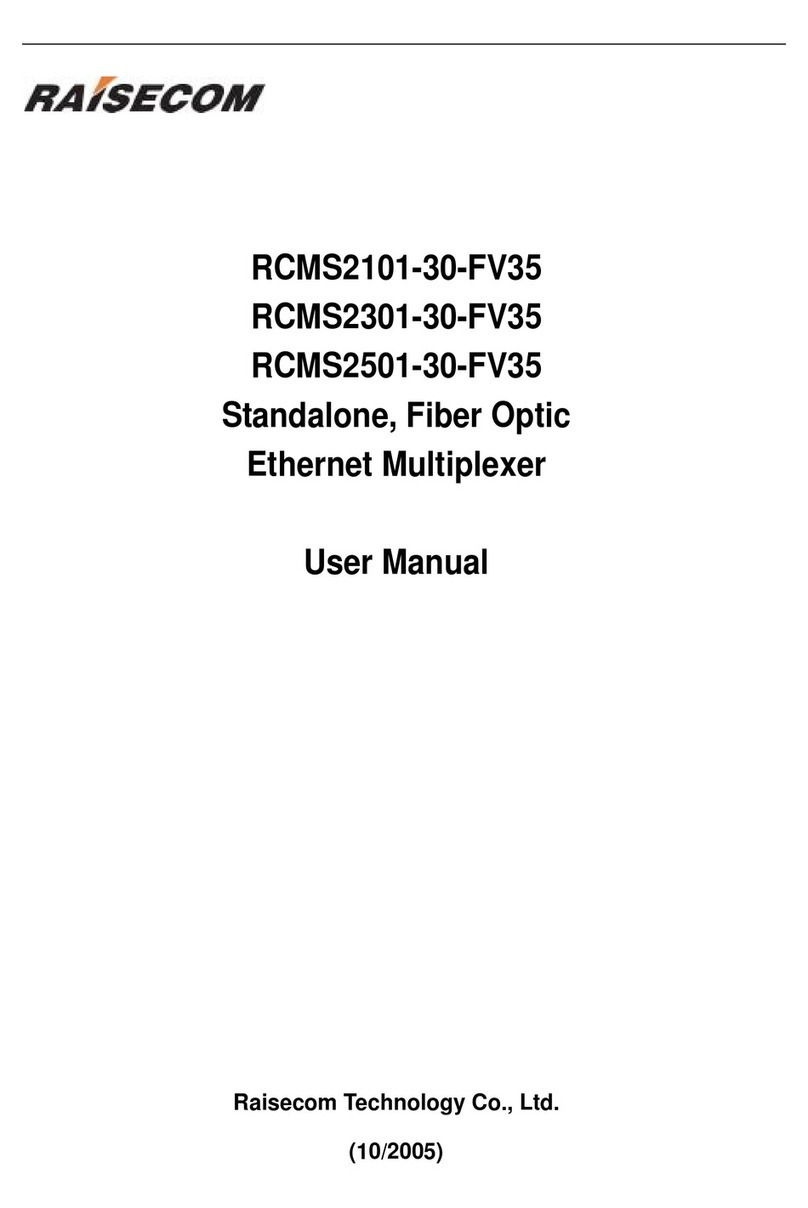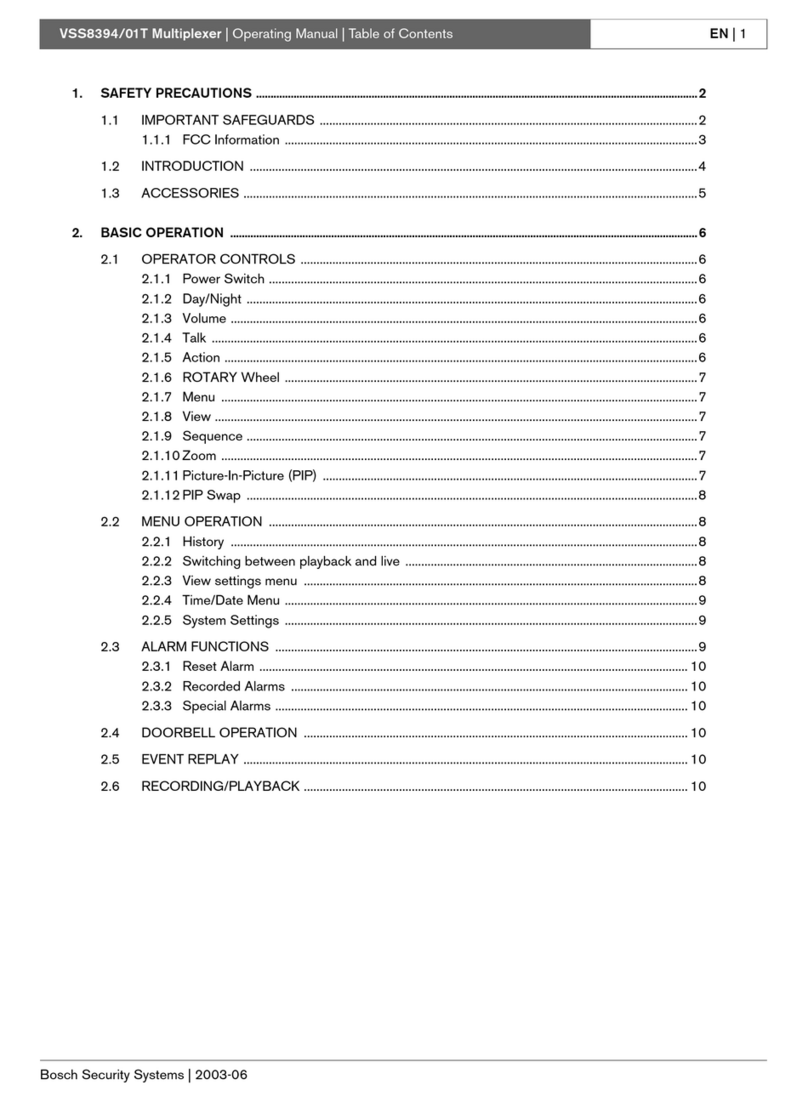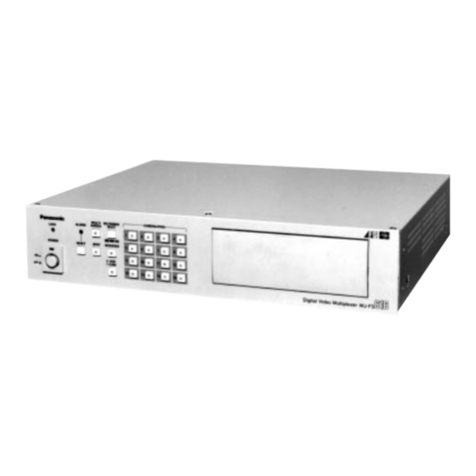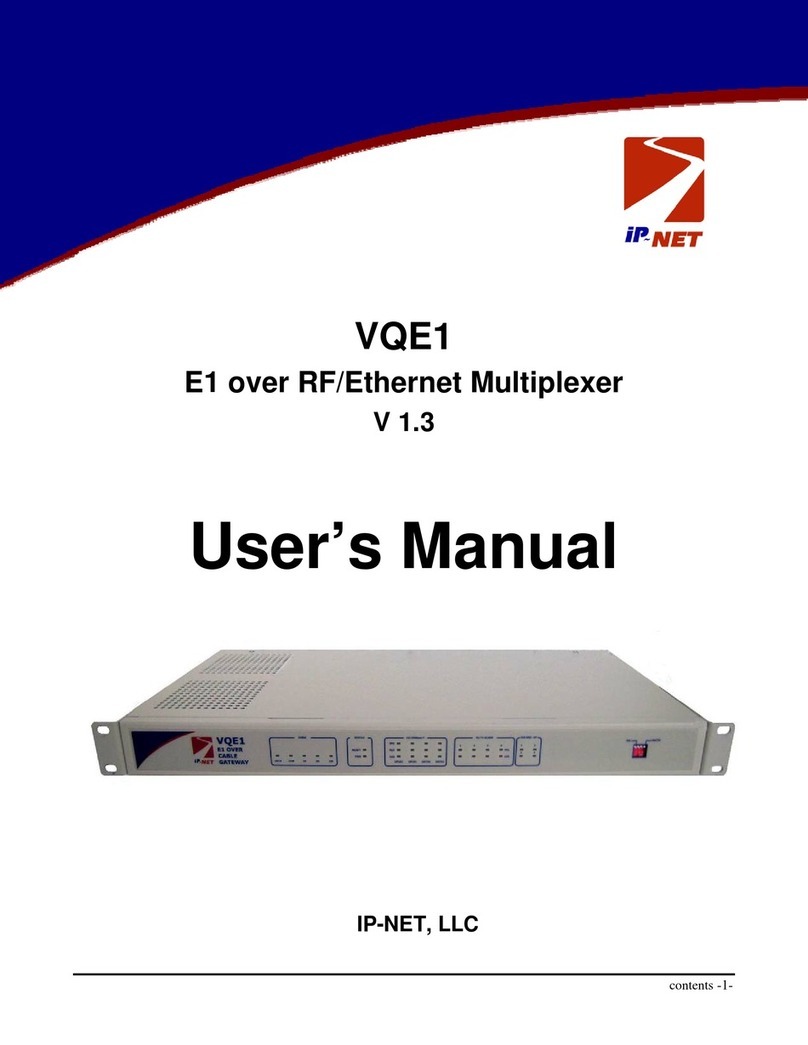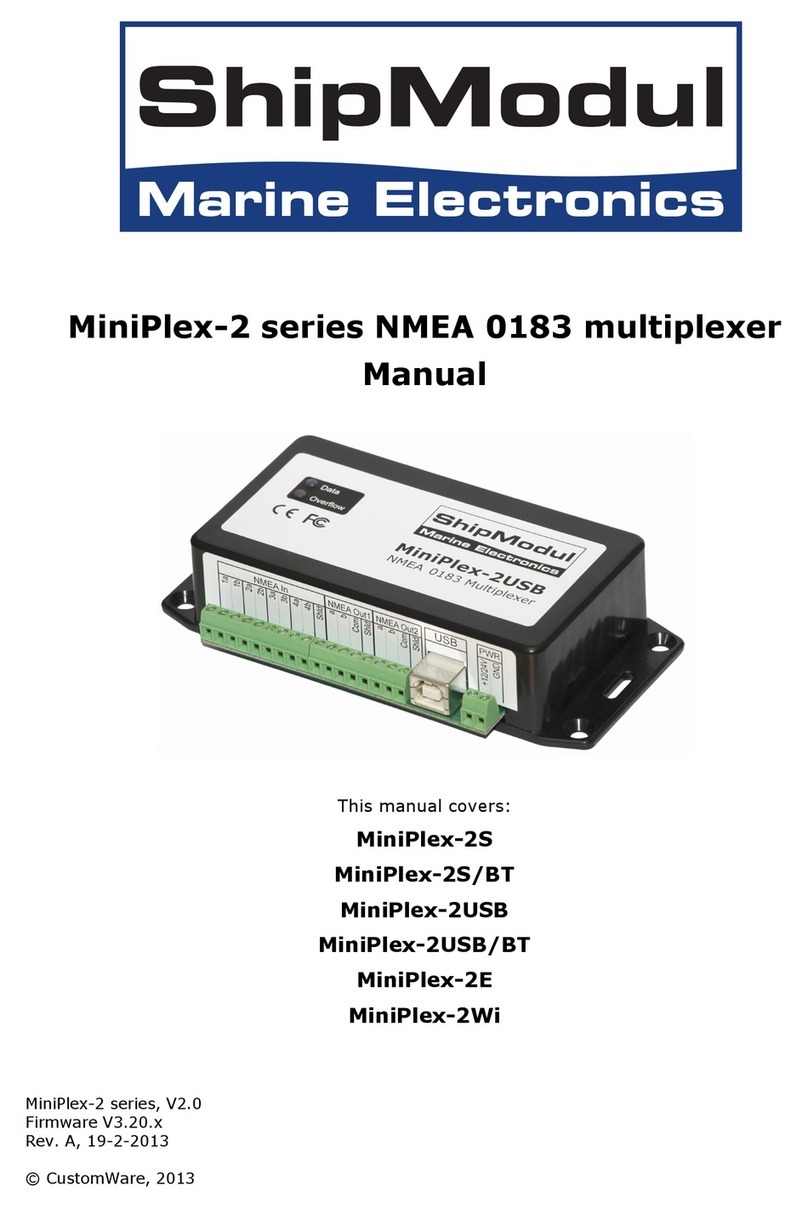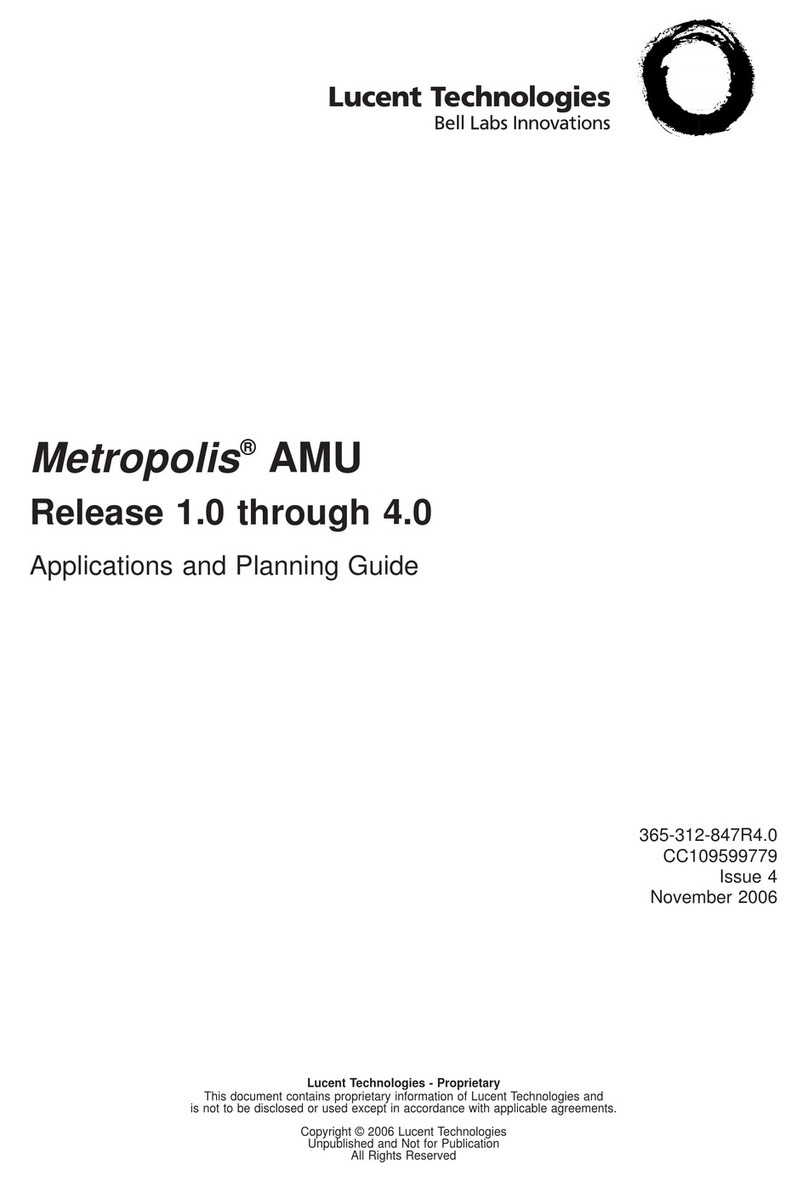Telecast Adder 882i User manual

Adder™ 882i
Intercom/Data Multiplexer
Instruction Manual
Telecast Fiber Systems, Inc.
102 Grove Street
Worcester, MA 01605
Tel: 508-754-4858
Fax: 508-752-1520
www.telecast-fiber.com

2

3
Table of Contents
Introduction 7
Unpacking 9
Installation 9
Rack Mounted Installation 9
Fiber Optic Installation 10
Audio Setup 10
Optical Connections 12
Electrical Connections 13
Intercom Modules 13
4-Wire 14
Clear-Com 14
RTS/Telex 15
Intercom Replacement 16
Digital Data 17
Power Connections 18
Input Power Fuse 19
Operating Details 19
Battery Charging 19
Indicators 19
Powering Up 20
Theory of Operation 21
Digital I/O 22
Optical 23
Preventive Maintenance 24
Accessory List 24
Troubleshooting 24
Specifications 25
Warranty 27

4

5
List of Figures
Figure 1. Front Panel of the Adder 882i 7
Figure 2. Single Fiber System 8
Figure 3. Other Optical Options 8
Figure 4. Installing the Rack Mount Adapters 9
Figure 5. 4-Wire Setup Controls 11
Figure 6. Main Circuit Board 12
Figure 7. ST Optical Connectors on Rear Panel 12
Figure 8. Intercom Module: 4-Wire (balanced) 14
Figure 9. Intercom Module: Clear-Com 15
Figure 10. Intercom Module: RTS/Telex 16
Figure 11. Data "D" Connectors on Front panel 18
Figure 12. Power Connector and Fuse Locations 18
Figure 13. Front Panel Indicators 19
Figure 14. Electronics Block Diagram 21
Figure 15. Digital I/O Connectors 1-4 22
Figure 16. Digital I/O Connectors 5-8 22
Figure 17. Battery Charger Block Diagram 23
List of Tables
Table 1. Maximum Fiber Lengths 10
Table 2. 4-Wire Inputs 11
Table 3. 4-Wire Connections 14
Table 4. Clear-Com Connections 14
Table 5. RTS/Telex Connections 16
Table 6. Digital Data Connections 17
Table 7. Power Connections 18
Table 8. Adder 882i Main Circuits 23
Table 9 Troubleshooting Chart 24

6

7
Introduction
The Telecast AdderTM 882i System consists of two Adder 882i fiber optic
multiplexer/ demultiplexers that simultaneously send and receive multiple
intercoms, eight digital datas, and four remote relay closures in each direction.
These signals are transmitted on optical fibers. Audio levels for 4-Wires are set
up by internal DIP switches that set amplifier gain to accept either mic or line
levels. Digital inputs and outputs are RS-422 and RS-232 compatible signals.
Four of the digital connectors also provide contact closure input and output. The
other four connectors alternatively provide SONY CCU compatible interfaces. All
connections except fiber and coax I/O and power are made via the front panel.
See Figure 1.
ADDER
882i
™
INTERCOM/DATA SYSTEM
Telecast
MADE IN USA
Fiber Systems, Inc.
1 2 3 4
EXTERNAL
POWER
INTERNAL
RESERVE
RECEIVE
STATUS
AUXILIARY
4-WIRE
AUDIO I/O
+8 dBm MAX
DATA/TALLY
DATA/CCU
POWER
1 2 3 4 5 6 7 8
A B
A B
+8dBm MAX LEVEL
600 Ohm
AUXILIARY
4-WIRE
AUDIO I/O
RTS
2-Wire
GAIN IN
GAIN OUT
NULL
B A
POWER
PORTS
TERM
ON
OFF
d
w
Clear-Com
2-Wire
POWER
PORTS
TERM
ON
OFF
d
w
GAIN
IN
OUT
NULL
A B
+8dBm MAX LEVEL
600 Ohm
AUXILIARY
4-WIRE
AUDIO I/O
Figure 1: Front Panel of the Adder 882i
Within the Adder 882i unit, the intercom audio signals are first digitized and then
multiplexed with the digital data and control signals. The combined electrical
signal is converted to an optical signal, launched into the optical fiber and sent on
to a second Adder 882i. This second unit receives the optical signal, converts it
into an electrical data stream, demultiplexes the signals and restores the audio
signals to analog levels.
An internal Ni-Cad battery provides backup in the event of line power loss.
The Adder 882i is available with several optical options and configurations.
• Standard connection with bidirectional signals carried on two optical
fibers at either 1300 or 1550 nm.
• One fiber connection with optically combined bidirectional signals at
1300/1550 nm as shown in Figure 2.
In a standard two-fiber system, identical Adder 882i units are used at each
location. The units both transmit at 1300 nm on the Tx ST connector and receive
the 1300 nm signal on the Rx ST connector. They are connected by the two
fibers so that the optical output of each box is connected to the optical input of
the other.

8
In a one-fiber system, the two Adder 882 units are not identical and are
configured before shipment. They must be used as a pair. The units are
connected by a single fiber that is wavelength division multiplexed (WDM). One
unit transmits from the Tx ST connector at a wavelength of 1300 nm and also
receives at 1550 nm on the same connector. The other unit transmits from the Tx
ST connector at 1550 nm and similarly receives at 1300 nm on the same
connector.
Figure 3 illustrates available optical configurations of the ADDER 882i.
Figure 2: Single Fiber operation
Figure 3: Other optical options

Unpacking
The Adder 882i System consists of:
• Two Adder 882i multiplexer/demultiplexer units
• Intercom Modules
• Two external power supplies (AC/DC adapters)
• Rack mount hardware
• Plastic or metal covers for optical connectors
Installation
Inspect the units for mechanical damage. Inspect all electrical connectors for
bent or damaged pins. Report any damage to the carrier and to Telecast Fiber
Systems, Inc.
Leave the protective plastic caps on the optical connectors until it is time to
attach the fiber(s) to the units. Place the caps back on the connectors whenever
the fibers are disconnected.
Rack Mounted Installation
Units are shipped ready for rack mount. Each “ear” adapter is held in place by
two #10 flat head screws (see Figure 4).
Figure 4: Installing the Rack Mount Adapters
Place the units in their intended locations before attaching any cables or wires.
This will prevent accidental damage to the cables or their connectors.

10
Fiber Optic Installation
The installer is responsible for providing the fiber optic cable runs that are
available from Telecast Fiber Systems, Inc. Refer to the Accessory List on page
18 of this manual for the cable and other items required for system installation.
Be sure that the fiber core diameters are compatible with the intended installation
distances as shown in Table 1.
Fiber core diameter
Maximum fiber length
50 micron
5 km (3 miles)
62.5 micron
3 km (2 miles)
8 micron (single mode)
10 km (6 miles)
Table 1: Maximum Fiber Lengths
The units have been configured at the factory for the fiber type with which they
are going to be used. Mark or tag the optical fibers when they are installed,
carefully avoiding the fiber tip, so that their identity is known at both ends. If there
is confusion about the identity of the two fibers, illuminate the end of one fiber
with a flashlight and look for the light at the other end.
WARNING: Do NOT use the Adder 882i optical output for this purpose.
Never look directly into the end of the optical fiber while either end of the
system is operating. Eye damage is possible.
Inspect the fiber ends and clean them with clean, dry compressed air or with
Kim-Wipes and isopropyl alcohol. Fingerprints or other dirt on the optical
connector end surfaces will reduce the received optical signal level.
Audio Setup
The setup switches for line or mic input levels are inside on the mother-board of
the Adder 882i. Setup steps are not required if all inputs are at the factory default
600 W, 0 dB gain, line level. This would include Clear-Com and RTS intercoms.
Setup is required for 4-Wire intercoms if mic level inputs are used, if 5 kW input
impedance is required, or if the optional 10 dB boost/cut is desired on line inputs.
Procedure
1. Determine which inputs will be used for 4-Wire applications where the
10 dB boost/cut can be used.
2. Copy Table 2 and fill in the required I/O characteristics.
3. With the power switch off, take off the top cover of the unit by removing
the #4 flat head screws at each corner.

11
4. With the rear of the unit facing you (connector end), move the slide
switches shown in Figures 5 and 6 to match the settings in Table 2.
The controls are arranged in pairs.
5. Replace the top cover and gently reinstall the screws.
In Figure 5, A refers to the first numbered channel and B refers to the second
numbered channel of the pair.
UNIT A SWITCH SETTING
1
2
3
4
5
6
7
8
8
10
MIC IN (0 or +40db gain)
LINE IN (0 or +10db gain)
Input Impedance (600 or 5k)
LINE OUT (0 or –10db gain)
UNIT B SWITCH SETTING
1
2
3
4
5
6
7
8
8
10
MIC IN (0 or +40db gain)
LINE IN (0 or +10db gain)
Input Impedance (600 or 5k)
LINE OUT (0 or –10db gain)
Table 2: 4-Wire Inputs
Figure 5: 4-Wire setup switches

12
These are printed
On the PC Board
Figure 6: Main PCB
Optical Connections
Refer to Figure 7 before beginning the optical connections.
Figure 7:Optical Connectors on the Rear Panel

13
WARNING: Never look directly into the end of the optical fiber while either
end of the system is operating. Eye damage is possible.
The Adder 882i is compatible with industry standard ST type connectors. It may
be used with installed backbone cables or with dedicated cables.
Assembled cables and connectors are available from Telecast Fiber Systems,
Inc. For custom cable fabrication, use type ST connectors such as Telecast part
number CONN-ST-M. Always follow the connector manufacturer’s directions
when fastening a connector to the cable. A Quick-crimp kit, part number CKIT-
3M-QC, is available from Telecast.
On a two fiber system, connect the cables so that the Tx at one end connects to
Rx at the other end. On a one-fiber system, connect the fiber optic cable to the
Adder 882i Tx connector at each end. The Rx ST bulkhead may or may not be
installed on one-fiber units.
In the same way, the system can be operated on two coaxial cables at distances
up to 300m. By connecting a coax from the TX on one side to the RX on the
other, a link can be made. You cannot run optical and coaxial links
simultaneously. These connectors are located directly above the optical
connectors on the rear panel.
The coax link can also be used with our Diamondback and Diamindback2
products. See those respective manuals for details.
Electrical Connections
Intercom Modules
Up to four intercom modules can be installed into the 882i. Two 4-Wires come
built-in on each 882i. Three types of intercom modules are available from
Telecast and shown in Figure 11 on page 10:
• Two balanced 4-wires
• Two Clear-Com 2-wires
• RTS compatible dual-channel 2-wire
Note: A 2-wire system can be interconnected with a 4-wire system or a different
type of 2-wire system but not all intercom functions will work (for example,
calling).
The intercom connectors are 3 or 5-Pin Male XLR’s; Switchcraft E3MST-AU or
E5MST-AU.

14
4-wire Auxiliary (balanced)
4-wire Auxiliary (balanced) intercoms use an individual 5-pin XLR on each of the
two channels in each module. Refer to Figure 8. XLR pin functions are given in
Table 3. Intercom Module Gain is 0 dB.
NOTE: 50 dB of gain may be added to 4-wire module inputs for MIC level
applications via a switch on the intercom Aux-piggyback board. See Audio Setup
on page 4.
PIN #
FUNCTION
Impedance
Signals
1
Ground
2
Input (+)
3
Input (-)
600 Ohm Input
MIC: +8 dBm
LINE: -32 dBm
4
Output (+)
5
Output (-)
>=600 Ohm Load
+8 dBm
Table 3: 4-Wire Intercom Connections
Figure 8: 4-Wire (Balanced) intercom Module
Clear-Com
Clear-Com intercom modules have a 3-pin XLR connector for each of the A and
B channels. This Telecast module fully supports the Clear-Com signaling
protocol and signal levels. The Clear-Com Intercom Connections are listed in
Table 4.
Pin #
Function
1
Ground
2
+ VDC Power
3
Audio
Table 4: Clear-Com Intercom Pin-out

15
NOTE: When using a Clear-Com external power supply, pin 3 termination must
be lifted on the power supply to prevent motor-boating.
Clear-Com operations are optimized by the use of the front panel adjustments
shown in Figure 9 and listed below:
• Input Gain, ±10 dB
• Output Gain, ±10 dB
• Null
Switches are also provided for:
•Dry/unpowered (d), or Wet/powered (w) PORTS
•200 Ohm on or off terminations TERM
Figure 9: Clear-Com 2-Wire intercom Module
The Telecast Clear-Com interface is compatible with powered and unpowered
belt packs as well as fixed equipment. You may power 5 to10 belt packs with
each intercom module from theViper’s internal power supply. Many more belt
packs can be added if powered externally. Refer to your intercom manufacturer’s
documentation for additional system details.
For operation with a belt pack, set the PORTS to w (wet/powered), the TERM to
ON and then center each of the INPUT gain, OUTPUT gain and NULL controls.
Re-adjust these controls to optimize performance as required.
RTS/Telex
RTS modules provide one two-channel intercom on a single 3-pin XLR
connector. This Telecast module fully supports the RTS signaling protocol and
signal levels.
RTS operations are optimized by the use of front panel adjustments as shown in
Figure 10 and listed below.
• Input Gain, ± 10 dB
• Output Gain, ± 10 dB
• Null

16
Table 5 lists the RTS/Telex pin numbers and intercom connections. Switches are
also provided for:
• Dry/unpowered (d), or Wet/powered (w) PORTS
• 200 W ON or OFF terminations TERM
Figure 10: RTS 2-Wire intercom Module
The interface is compatible with powered and unpowered belt packs as well as
fixed equipment. You may power 5 to 10 belt packs with each intercom module.
Refer to your intercom manufacturer’s documentation for additional system
details.
For operation with a belt pack, set the PORTS to w (powered), the TERM to ON
and then center each of the INPUT gain, OUTPUT gain and NULL controls. Re-
adjust these controls to optimize performance as required.
Pin #
Function
1
Ground
2
+ VDC Power & Ch.1 Audio
3
Ch.2 Audio
Table 5: RTS Intercom Pin-out
Intercom Module Replacement
Intercom modules within the Viper are installed by Telecast in accordance with
your purchase order. Should you want to change or add modules, you may have
to reset certain switches on the 882i mother-board.
Cable Harnesses
Two multi-conductor cable harnesses connect to the intercom module within the
882i. These cables connect the module to power and signal sources. The first
has ten conductors and connects the data sub-assembly board to the intercom
module. The second has three conductors and supplies power from the DC-DC
converter mounted against the side panel of the 882i. The connectors are Amp-

17
MTA type connectors and they fit all three module types. Use care when inserting
and removing these connectors. When using a 4-Wire module, the 3-pin power
connector is not used since no power is required. Be careful to locate this jumper
in a location where it will not cause an electrical short with other components.
To change an intercom module in the assembly:
1. Turn the power OFF.
2. Remove the four screws that attach the module to the 882i frame.
3. Pull the module half-way out and disconnect the two multi-conductor
cables.
4. Remove module.
5. Carefully insert the new module half-way and attach the two multi-
conductor cables.
6. Re-install the four mounting screws.
7. Turn the power ON.
Digital Data
Digital signal connections are made via the 9-pin “D” connectors described in
Table 6 and illustrated in Figure 11. A 110 W terminating resistor placed across
the balanced inputs may be needed if cable lengths using 110 W twisted pairs
are in excess of 6 feet. The serial communications protocol can be RS-232 at
one end and RS-422 at the other, if desired.
Contact closure input is activated by connecting it to ground. Contact closure
output is an isolated dry contact.
If SONY CCU interface operation is selected, RS-422 and RS-232 functions are
not available at that connector
The digital I/O “D”connector is AMP 747905-2.
Connectors 5-8 (Right)
PIN #
Connectors1-4 (Left)
Serial Comm
CCU Data
1
RS422 in (-)
RS422 in (-)
No Connection
2
Contact Out
No Connection
CCU I/O
Jumper to Pin 6
3
Ground
Ground
Ground
4
RS-232 Out
RS-232 Out
No Connection
5
RS-422 Out (-)
RS-422 Out (-)
Jumper to Pin 8
6
RS-422 In (+)
RS-232 In
RS-422 In (+)
RS-232 In
CCU I/O
Jumper to Pin 2
7
Contact Out
No Connection
No Connection
8
Contact In
No Connection
Jumper to Pin 5
9
RS422 out (+)
RS422 out (+)
No Connection
Table 6: Data Connections

18
ADDER
882i
™
INTERCOM/DATA SYSTEM
Telecast
MADE IN USA
Fiber Systems, Inc.
1 2 3 4
EXTERNAL
POWER
INTERNAL
RESERVE
RECEIVE
STATUS
AUXILIARY
4-WIRE
AUDIO I/O
+8 dBm MAX
DATA/TALLY
DATA/CCU
POWER
1 2 3 4 5 6 7 8
A B
A B
+8dBm MAX LEVEL
600 Ohm
AUXILIARY
4-WIRE
AUDIO I/O
RTS
2-Wire
GAIN IN
GAIN OUT
NULL
B A
POWER
PORTS
TERM
ON
OFF
d
w
Clear-Com
2-Wire
POWER
PORTS
TERM
ON
OFF
d
w
GAIN
IN
OUT
NULL
A B
+8dBm MAX LEVEL
600 Ohm
AUXILIARY
4-WIRE
AUDIO I/O
Figure 11: Data “D” Connectors
Power Connection
When using the standard Telecast power supply, connect the 4-pin XLR
connector to the Adder 882i and plug the supply into a 120 VAC line. See Figure
12.
Figure 12: Power Connector and Fuse locations
Any power supply used with the Adder 882 must supply 1.5 amperes continuous
current. Use the wiring connections shown in Table 7. The power connector is
Switchcraft D4M.
Pin #
Signal
1
Ground
2
Not used
3
Not used
4
+12-24VDC (<30VDC MAX)
Table 7: Power Connector Pin-out
Female 9-Pin “D”

19
Input Power Fuse
The 2 ampere time delay power fuse is accessible from the rear panel (see
Figure 13). Be sure to use the same fuse type if replacement is required.
Operating Details
Battery Charging
Charge the internal UPS batteries at a minimum 13.8 VDC for 16 hours (40 mA
trickle charge) by attaching each unit to its external power supply. This will permit
battery operation for up to 20 minutes during line power losses.
Indicators
The three LEDs on the front panel are shown in Figure 13.
ADDER
882i
™
INTERCOM/DATA SYSTEM
Telecast
MADE IN USA
Fiber Systems, Inc.
1 2 3 4
EXTERNAL
POWER
INTERNAL
RESERVE
RECEIVE
STATUS
AUXILIARY
4-WIRE
AUDIO I/O
+8 dBm MAX
DATA/TALLY
DATA/CCU
POWER
1 2 3 4 5 6 7 8
A B
A B
+8dBm MAX LEVEL
600 Ohm
AUXILIARY
4-WIRE
AUDIO I/O
RTS
2-Wire
GAIN IN
GAIN OUT
NULL
B A
POWER
PORTS
TERM
ON
OFF
d
w
Clear-Com
2-Wire
POWER
PORTS
TERM
ON
OFF
d
w
GAIN
IN
OUT
NULL
A B
+8dBm MAX LEVEL
600 Ohm
AUXILIARY
4-WIRE
AUDIO I/O
Figure 13: Front Panel LED Indications
• External Power When this green LED is illuminated, an external supply of
between 12 and 24 VDC is connected.
• Internal Reserve This LED is illuminated green when the power is on and the
internal battery is adequately charged. This LED lights after
one half hour of charge. There may be a few minutes of
reserve after the indicators extinguish. This LED is
illuminated red when the internal battery is discharging.
• Link Status This red LED is on when the fiber optic link is not properly
attached, or the system units are not communicating
properly. This indicator is meaningful only if one of the other
two LEDs is on.
An audible alarm has been incorporated into the Adder 882 in addition to the
LED indicators on the front panel. This alarm alerts the user that the internal
batteries are discharging. A defeat switch for the audible alarm is located inside
the unit on the main circuit board.

20
Powering Up
A locking switch is provided to prevent inadvertent power turn off. Never try to
move the front panel switch without first pulling on the switch lever to disengage
its lock.
With power OFF at both units, check all electrical and optical connections as
described in Installation on page 2. Firmly seat and latch all connectors. To
operate the power switch:
1. Pull the lever away from the panel.
2. Move it up for power ON, or down for power OFF.
The power switches at both units must be on for the system to achieve normal
function.
3. Switch on the power to both Adder 882i units.
Verify that the green external power LEDs are illuminated, and that the red link
status LEDs do not light. If you do not get this result, refer to the Troubleshooting
Chart on page 18. Remember that LINK LED OUT at both ends indicates that the
units are locked and functioning properly.
Table of contents
Other Telecast Multiplexer manuals

